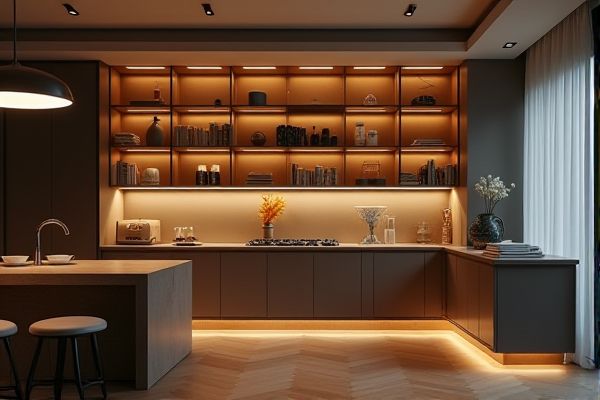
Under-shelf lighting provides focused illumination that enhances tasks and highlights specific areas, while overhead lighting offers broader, more general light coverage for an entire room. Discover how choosing between under-shelf and overhead lighting can transform your space by reading the rest of the article.
Table of Comparison
| Lighting Type | Under-Shelf Lighting | Overhead Lighting |
|---|---|---|
| Placement | Mounted beneath shelves | Ceiling-mounted or recessed |
| Purpose | Task lighting for work surfaces | General ambient room lighting |
| Light Distribution | Focused, localized illumination | Wide, even coverage |
| Energy Efficiency | Low power LED options often used | Higher wattage options possible |
| Installation Complexity | Requires shelf mounting, wiring | Usually simpler ceiling installation |
| Glare & Shadows | Minimizes shadows on work area | Can cause shadows under objects |
| Cost | Moderate, depends on type and length | Varies, often higher for large fixtures |
| Ideal Use | Kitchens, offices, display illumination | Living rooms, hallways, general lighting |
Understanding Under-Shelf and Overhead Lighting
Under-shelf lighting provides targeted illumination that enhances visibility by reducing shadows and highlighting specific areas beneath shelves, making it ideal for task-oriented spaces like kitchens or workstations. Overhead lighting offers broader, ambient light coverage that uniformly brightens entire rooms but may cause glare or uneven lighting in detailed tasks. Understanding the distinct advantages of under-shelf versus overhead lighting helps you select the most efficient solution for your workspace or living area.
Key Differences Between Under-Shelf and Overhead Lighting
Under-shelf lighting provides focused illumination directly beneath cabinets or shelves, enhancing task visibility and reducing shadows on countertops, while overhead lighting offers broader ambient light that brightens entire rooms. Under-shelf lighting typically uses LED strips or puck lights for energy efficiency and subtlety, whereas overhead lighting often employs ceiling-mounted fixtures or recessed lights to cover larger areas. Understanding these key differences helps you choose lighting solutions that optimize both function and aesthetic in your space.
Advantages of Under-Shelf Lighting
Under-shelf lighting provides targeted illumination that enhances visibility on countertops and workspaces, reducing shadows caused by overhead lighting. It creates a modern and aesthetically pleasing ambiance, highlighting kitchen backsplashes or display items without overwhelming the room's overall lighting design. Energy-efficient LED under-shelf fixtures offer customizable brightness levels, contributing to both functionality and energy savings compared to traditional overhead lights.
Benefits of Overhead Lighting Solutions
Overhead lighting solutions provide uniform illumination that enhances visibility across entire rooms, making them ideal for general tasks and activities. These lighting options, such as recessed lights, pendant fixtures, or ceiling-mounted LEDs, contribute to balanced brightness and reduce shadows compared to localized under-shelf lighting. Overhead lighting also supports energy efficiency by enabling the use of fewer fixtures to illuminate larger spaces effectively.
Applications and Ideal Use Cases
Under-shelf lighting is ideal for illuminating workspaces, display cabinets, and kitchen countertops where targeted, task-specific lighting enhances visibility and detail. Overhead lighting suits broader illumination needs in living rooms, offices, and commercial spaces, providing uniform light coverage for general activities. Combining both lighting types maximizes functionality by balancing ambient light with focused accents.
Energy Efficiency Comparison
Under-shelf lighting typically uses LED strips or puck lights that consume significantly less energy than traditional overhead lighting fixtures, which often rely on higher wattage bulbs. This targeted illumination reduces overall energy consumption by focusing light where it is needed most, minimizing waste. Overhead lighting generally requires more power to evenly light larger areas, resulting in higher energy usage and increased operational costs.
Installation and Maintenance Considerations
Under-shelf lighting typically requires minimal installation effort, often involving adhesive strips or simple mounting brackets, making it ideal for DIY projects and tight spaces. Overhead lighting installation may demand professional electrical work and ceiling modifications, increasing both complexity and cost. Your choice should factor in ease of access for maintenance; under-shelf lights offer straightforward bulb replacements or LED strip swaps, whereas overhead fixtures might necessitate ladder use and more involved upkeep.
Cost Analysis: Upfront and Long-Term
Under-shelf lighting typically has a lower upfront cost due to smaller fixtures and simpler installation compared to overhead lighting, which often requires extensive wiring and larger fixtures. Long-term energy consumption is generally lower with under-shelf LED options, reducing electricity expenses significantly over time, whereas traditional overhead lighting may incur higher operational costs depending on the bulb type. Maintenance costs for under-shelf lighting tend to be minimal because of easy access and durable LED technology, while overhead lighting can require more frequent replacements and professional servicing.
Design and Aesthetic Impact
Under-shelf lighting provides targeted illumination that highlights specific areas and enhances the visual appeal of shelving displays, creating a warm and inviting atmosphere. Overhead lighting offers broader, more uniform light distribution, contributing to an open and spacious feel in the entire room. Your choice between these lighting options influences the overall design aesthetic, emphasizing either focused accents or general ambient brightness.
Choosing the Right Lighting for Your Space
Under-shelf lighting offers targeted illumination perfect for highlighting workspaces and reducing shadows, enhancing task visibility with lower energy consumption. Overhead lighting provides broad, uniform light that covers entire rooms, ideal for general ambiance and overall brightness. Evaluating your space's purpose and layout helps you select the right combination to balance functionality and aesthetics effectively.
 homyna.com
homyna.com